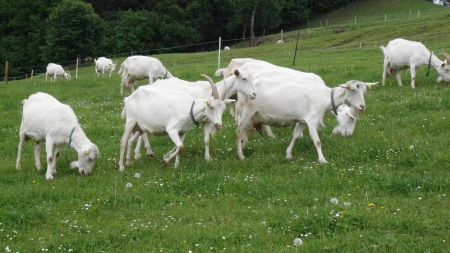Grazing time is either during the day (between morning and evening milking) or during the night (between evening and morning milking). The milk yield, milk ingredients, parasite load and feed intake during stable keeping are examined.
The grazing of dairy goats is often viewed as problematic. Goats react very quickly to changing weather conditions and different feed availability with different feed intake and this has a direct impact on milk production. Parasites, which in most cases are associated with grazing, can also become a problem.
In this project, the short-grass pasture system, which works very well in cattle farming, is to be examined in a dairy goat herd. In addition, the influence of day or night grazing should be examined. Day or night grazing could result in different pasture feed intake and different parasite loads. This project aims to investigate whether this is actually the case and how this affects performance.
The LFZ's existing goat herd is divided into 2 groups of a maximum of 14 goats each (depending on lambing results). Division is based on milk production and body weight. At the start of the growing season (probably mid-April), the goats are kept on a short-grass pasture alternately during the day or night. The daily grazing time per group is 10 hours. The goats in the two experimental groups each graze on their own pasture area, which has the same vegetation. The pasture area is calculated so that an average growth height of 6 - 8 cm is given. The growth height is measured twice a week. If the growth height increases beyond this, the area is reduced; if it decreases, the area is increased.
During the stable period, the exact individual feed intake of the goats is determined. The goats are offered rationed hay and concentrated feed. Half of the concentrated feed is administered at the milking parlor for each milking. The individual milk quantity is measured with each milking. A milk sample is taken twice a week and the milk is examined for its ingredients. Before the start of the grazing period, 4 weeks after the start of grazing and towards the end of the grazing period, a milk sample is taken and the fatty acid pattern is determined.
Before grazing begins, all goats are dewormed and the success is checked by examining fecal samples. During the grazing period, a fecal sample test is carried out once a month to determine the number of eggs per gram of feces. The goats are weighed once a week after morning and evening milking.
In addition to animal health and its costs, feed intake, feed costs and performance are the most important economically relevant parameters. The economic impact of the pasture system can be assessed based on the data obtained and forms an essential part of the evaluation.
The knowledge gained regarding grazing of dairy goats can be an important basis for decision-making for possible pasture management for dairy goat farmers. Furthermore, knowledge of the influence of feeding or husbandry on milk quality is of interest and this can be of assistance in the marketing of goat milk.







